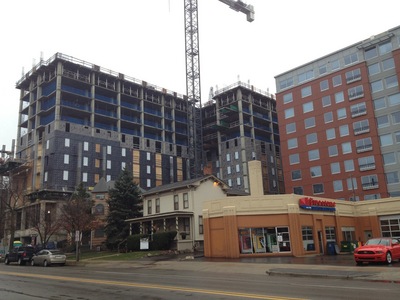Now that Ann Arbor has had a chance to see a number of developments come forward under the city's newer downtown zoning, Sabra Briere says it's time for a review.
The 1st Ward City Council member is sponsoring a resolution on tonight's agenda to direct the city's Planning Commission to review the D1 and D2 zoning regulations for downtown.
If passed as proposed, the resolution would establish a six-month moratorium on new developments in the downtown to give city officials time to consider whether the zoning truly reflects the goals the community has identified for downtown and adjacent neighborhoods.

The Varsity high-rise taking shape along Huron Street in December.
Ryan J. Stanton | AnnArbor.com
Briere said a handful of projects that have come up in the last few years — including new student high-rises — provide sufficient opportunities to review the downtown zoning.
The D1 zoning limits building height on new developments along South University and the 400 block of East Huron to 150 feet, while the rest of East Huron, East Washington, East Liberty and the north side of East William is capped at 180 feet. D2 zoning, intended to provide a transition between the downtown core and adjacent neighborhoods, caps building height at 60 feet.
Despite attempts to improve the zoning for downtown, Briere said, developers still can present a project that fits the zoning, but doesn't fit any of the community values the council and the Planning Commission attempted to build into the process
"I sit on the Planning Commission and hear members of council, the Planning Commission and the community voice their concerns about whether the process is working as we wanted," she said.
Briere said it's time to evaluate the impact of D1 and D2 zoning on adjacent neighborhoods, especially where there is no interface zone between D1 and residential properties.
Her resolution stipulates that the Planning Commission will make recommendations to the City Council by June 30 and that the council will take action on those recommendations by Aug. 31.
The resolution spells out that any petitions for site plan approval would be deferred for six months, but that would not affect projects that do not require an approved site plan or applications and permits that involve routine repair and maintenance for an existing permitted use.
"I'm going to be listening closely and I'm going to be speaking with the city's attorneys, as I think other council members will be," Mayor John Hieftje said of where he stands on Briere's resolution. "I want to get the full picture. I'll certainly give it some thought and I look forward to the discussion."
Hieftje said it's fair to point out a review of the new downtown zoning should have taken place before now and it didn't, so he thinks it's timely — with or without an accompanying moratorium.
Asked whether the moratorium could hold up the controversial 413 E. Huron high-rise, which is working its way through the city's approval process, Hieftje said that's possible.
Some have argued the 400 block of Huron should be zoned D2 instead of D1 to provide additional protections for the historic neighborhood to the north. Hieftje said he sees the concerns of residents, and that was a tough issue when the zoning was decided, but he supports D1 zoning there.
"Council had a considerable debate about it," he recalled, pointing out Huron Street is one of the widest streets downtown and is a US-23 business route.

Sabra Briere
Ryan J. Stanton | AnnArbor.com
In 2004, after the city received the results of the study and the task force recommendations, the city held meetings to help determine how the community wanted to see the downtown change, and what elements of downtown the community wanted to protect and enhance.
The resulting report, often referred to as the Calthorpe plan, formed the base of the A2D2 (Ann Arbor Discovering Downtown) task force, Briere said. Those efforts eventually resulted in the final rezoning of downtown in 2009 and the adoption of downtown design guidelines in 2011.
Built into the resolution approving the rezoning of downtown was an expectation that the Planning Commission would review the zoning after a year, Briere recalled, but the commission delayed the review until there were several examples to consider.
Before 2009, Briere said, downtown Ann Arbor had a patchwork of use-defined zoning. The increased demand to have mixed uses in new construction, she said, meant each new building proposed didn't fit the zoning and needed to come in as a Planned Unit Development.
"PUD projects tended to be controversial in the downtown, and were likely to be contentious," she wrote in her email to residents. "As a result of a lot of community discussion, the council amended the zoning in downtown to be a hybrid of use-defined and form-based zoning."
Ryan J. Stanton covers government and politics for AnnArbor.com. Reach him at ryanstanton@annarbor.com or 734-623-2529. You also can follow him on Twitter or subscribe to AnnArbor.com's email newsletters.